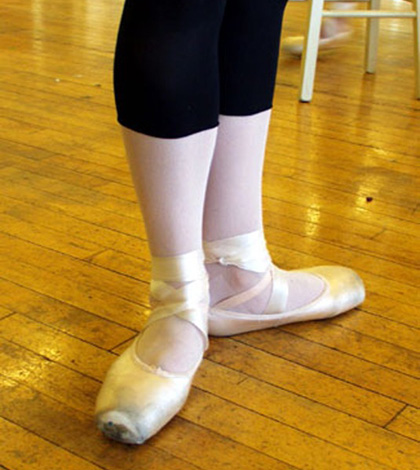Have you ever heard your dance instructor caution you in a stern voice to “Watch your turn out!”?
If so, you’re not alone — almost all forms of dance, from ballet and ballroom to hip hop and tap, require some degree of turn out in order to achieve good technique.
In fact, the proper use of turn out not only looks good, it is also healthier for your joints, muscles and supporting ligaments. While 180 degree turn out may look impressive, very few people have the physical capacity for such perfect turn out. Dancing safely means working up to your own personal maximum and then developing the strength and control to maintain that degree of turn out at all times when dancing. Turn out should come from external rotation of the hips, and not from the knees or feet. Try to avoid clenching your gluteus maximus, and instead use the muscles that are located deeper within the buttock, such as the piriformis. A good test to see if your turnout really is coming from your hips is to bend your knee into a plié or fondu: knees should always be lined up over the toes, feet & ankles should not roll inwards, and baby toes should stay on the floor. Proper turn out is extremely important for dancers because poor turn out can lead to a number of traumatic and repetitive strain injuries in the:
-
feet & ankles
-
knees
-
hips, and
-
lower back
In the event that you do injure yourself, visit your chiropractor for appropriate care before the problem becomes worse or affects your performance.
How does poor turn out affect my body?
Feet & Ankles
When a dancer does not demonstrate enough turn out at the hips — either due to anatomical limitations or a lack of muscular control — it is tempting to compensate by forcing additional turn out at the knees. This may give the illusion of greater turn out because it allows the feet to approach the desired 180 degrees, but it also places a great deal of stress and strain on the medial aspect of the feet and ankles. Dancing in this position should be avoided, as it causes the feet to roll inwards resulting in micro-trauma to the deltoid ligament of the ankle, overpronation of the feet and flattening of the longitudinal arches of the feet. These biomechanical changes can lead to conditions such as medial ankle sprains, tarsal tunnel syndrome and plantar fasciitis.
Knees
Failing to maintain muscular control of your turn out while dancing can create significant torsional strain at the knees. For example, if you are not holding your turn out at the hips but at the same time you have your feet firmly planted in a well turned out classical first position, it is your knees that are left to make up the difference. Biomechanically, the knees were not meant to function like this! If you jump out onto or transfer your weight through the knee while it is under such torsional strain, a considerable amount of stress will be placed upon the supporting ligaments along the medial aspect of the knee, possibly leading to ligamentous laxity or sprain. In addition, it can also interfere with the normal movement and tracking of your knee cap (patella) and cause repetitive micro-trauma to the meniscus, which is a crescent shaped disc of fibrocartilage that acts as a shock absorber within the knee.
Hips
In classical dance, external rotation of the hips is a part of almost every movement, step and position. Even when done properly, this constant turn out can lead to muscle imbalance! Regular stretching of the piriformis and other surrounding gluteal muscles will help to keep the hips and pelvis healthy and in balance. A good stretch to start with is done by pulling your right knee up to your left shoulder while lying on your back. Hold this stretch for a few deep breaths, and then repeat by brining the left knee up to the right shoulder. This is called the “knee across chest” stretch. Next, try the “figure 4” stretch for the piriformis. Sit in a chair with knees bent and feet on the floor. Lift up and cross the right ankle over the left knee and let the leg fall open into a figure 4 type position. Sit up tall, reach your chest forward and feel the stretch in your right buttock!
Lower Back
Poor turn out at the hips will most certainly have an effect on your lower back, especially when performing developés and grands battements à la seconde. Leg extensions à la seconde that are done with poor turn out force the hip to lift up into the dreaded “doggie at a fire hydrant” position. Not only does this look bad (and make your dance instructor very unhappy) it can also cause a number of lower back injuries! In order to accommodate the lifted hip, your lower back is forced to pinch in at the side which can lead to repetitive strain of the quadratus lumborum and erector spinae muscles. In addition, lifting the hip can also push your spine into extension causing irritation and pain along the joints of the lumbar spine and pelvis. Avoid these problems by training with good technique — start with a well placed tendue and remember to hold your turn out and drop the hip as you complete the battement!
Dr Twardowski is a classically trained dancer with professional credits including Beauty and the Beast & Joseph and the Amazing Technicolor Dreamcoat. His Chiropractic and Acupuncture clinic is located in Toronto at Bayview and Sheppard. Contact: 416 226 2552
This article may not be published, broadcast or redistributed without consent from danceScape™. Please contact[email protected] for authorization details.
